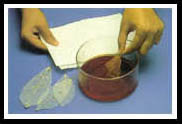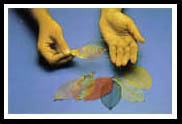






Click on an image to see a larger version.
Also, see the Venation Chart for more info.
1.) You can either boil your leaves, pressure-cook your leaves, or both. When you boil your leaves be very careful: Baking soda is very basic, and washing soda is even more so. (Remember: base is the opposite of acid, and can be just as harmful!) Boil your leaves for about an hour making sure that they stay submerged. If you pressure-cook them, leave them for about twenty minutes.
2.) Remove a leaf from the solution with tongs, and then submerge it in a bowl of clean water to rinse.
3.) Transfer the leaf to a paper towel. Spray the leaf with water, and brush it with the paint brush so that it lays flat. Keep the leaf as wrinkle-free as possible.
4.) Using the blunt end of a butter knife, scrape away at the leaf along the veins. Different leaves require different pressures. You don't want the leaf to break, so be as gentle as you can. If membranes start to peel away, use tweezers to help them.
Keeping the leaf damp helps this process. For really delicate leaves that survived the boiling process, brushing with a paint brush is sometimes enough to remove the cell layers. Be diligent!
5.) Turn the leaf over gently, and scrape the other side. Dab at the leaf with the paint brush, bringing the bristles straight down each time (like stenciling).
If your leaf is too delicate, and the veins begin to tear, do this:
a) put the leaf between to paper towels, remembering to keep the leaf moist
b) beat the paper towels with the sturdy brush. Come straight down each time as a side-to-side motion could tear the veins apart.
c) when you've really given the leaf a good pounding with the brush, gently remove the top paper towel. You should see pieces of the leaf that you don't want are sticking to this towel. Put the leaf between two fresh paper towels.
d) repeat as many times as necessary to get the desired results
It seems that this won't work for delicate leaves, but it does! The veins are composed of lignin... and this is the toughest material you'll find in the leaves.
6.) When you are satisfied that your leaf is a skeleton, soak the skeleton in a 1:5 solution of bleach for several hours, or even overnight (it depends on how white you want it), and then soak it in a bowl of fresh water. Bleaching will make the skeleton soft, however, so if you have a leaf that continuously folds on itself when you're trying to take it out of the water, do this:
a) keep the leaf in the bleach solution/fresh water
b) submerge a 4x6 index card and float the leaf skeleton over to it
c) keep the top of the leaf flat against the card when you pull it out of the water; try to keep the leaf from wrinkling (this may take some time so be patient).
You may have to make several attempts to remove the leaf from the water. Try bobbing the card up and down as you lift it to flatten out the wrinkled parts.
7.) Leave your leaf skeleton to dry on a solid surface. If you removed your leaf from the water using an index card, allow both the leaf and card to dry completely.
8.) Being gentle, and possibly using tweezers, lift the leaf skeleton away from the surface/paper. Use even pressure and go slowly. Even delicate leaves can be done this way.
Copyright ©2008 RJMc. All Rights Reserved.